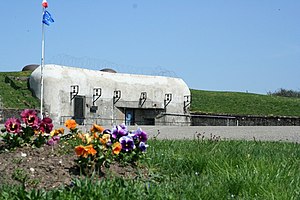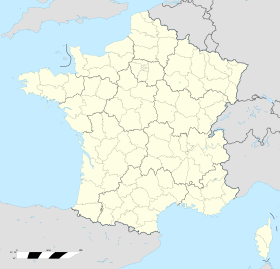Ouvrage Rohrbach
| Ouvrage Rohrbach | |
|---|---|
| Part of Maginot Line | |
| Northeast France, New Fronts | |

Ouvrage Rohrbach
|
|
| Coordinates | 49°03′41″N 7°16′12″E / 49.06139°N 7.27°E |
| Site information | |
| Controlled by | France |
| Open to the public |
Yes |
| Site history | |
| Built by | CORF |
| In use | Preserved |
| Materials | Concrete, steel, deep excavation |
| Battles/wars | Battle of France, Lorraine Campaign |
| Ouvrage Rohrbach | |
|---|---|
| Type of work: | Small infantry work (Petit ouvrage - infantry) |
|
sector └─sub-sector |
Fortified Sector of Rohrbach └─Bining |
| Work number: | O 250 |
| Regiment: | 166th Fortress Infantry Regiment (RIF) |
| Number of blocks: | 3 |
Ouvrage Rohrbach (or Fort Casso) is a petit ouvrage of the Maginot Line located in the community of Bettvillier, near Rohrbach-lès-Bitche in the Moselle département, facing Germany. The Fortified Sector of Rohrbach was built somewhat later than its neighbors to the east and west, and in company with positions on the extreme western end of the Maginot Line, became one of the "New Fronts."
Early designs contemplated a powerful fortification of thirteen blocks. However, the scale of works in the Rohrbach sector was reduced in 1933 to two gros ouvrages, one petit ouvrage (Rohrbach), fifteen casemates and eight shelters (abris). The fortifications center around the military camp at Bitche and the village of Petit-Réderching. No works were constructed in Rohrbach itself. As a result of the decision of Marshal Pétain in 1929, priority was given to the Vosges and the defense of the plain of Alsace. Aware of the weakness of the area between the rivers Sarre and Lauter, three gros ouvrages were proposed, to be completed between 1929 and 1933. However, in 1934, due to budget restrictions, plans were deferred for artillery blocks at Rohrbach, and only the infantry blocks were ultimately constructed.As the project progressed, it was distributed among Rohrbach and its neighbors.
The site was surveyed by CORF (Commission d'Organisation des Régions Fortifiées), the Maginot Line's design and construction agency, and was approved for construction in June 1934. The petit ouvrage was to be expanded in a second phase to a gros ouvrage with separate munitions and personnel entries, an "M1" magazine, full underground caserne, two 75mm gun turrets, a 135 mm gun turret, a casemate block with three 75mm guns and a long-range 145mm gun turret.
The town of Rohrbach-lès-Bitche is located on a shelf between the Vosges mountains and the valley of the Sarre, tunneled beneath by plaster mines. The valley extends into Germany and forms a natural axis of attack. The constructed p;ortions of Rohrbach are on the edge of an escarpment, while most of the proposed additional blocks, as well as the entries, were to be located several hundred meters to the rear in a ravine, tunneled under the village.
...
Wikipedia

